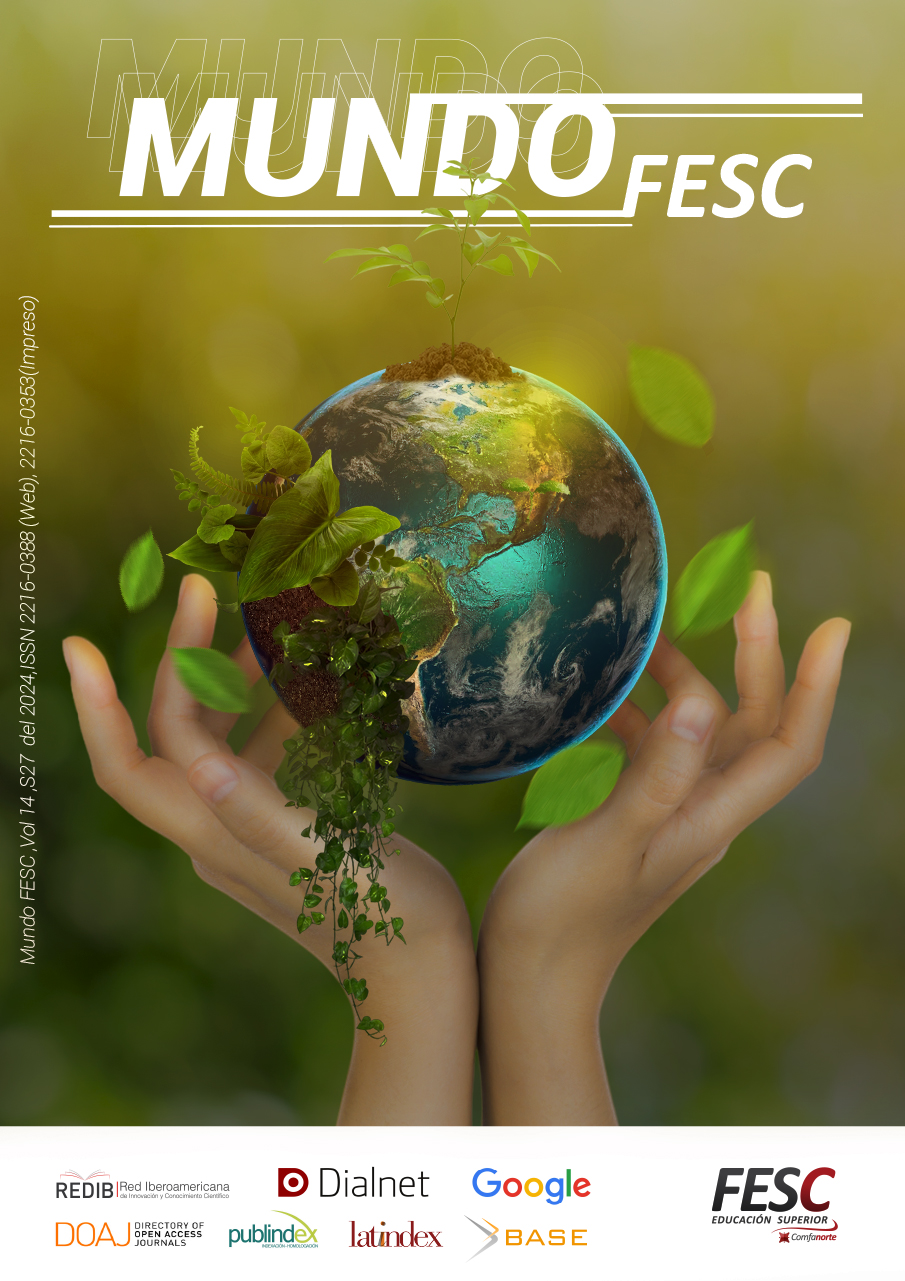Analysis of biopolymeric starch films for potential application in optoelectronics
DOI:
https://doi.org/10.61799/2216-0388.1591Keywords:
Biopolymer, Starch, Aquatic plants, Dimethyl sulfoxide, Optoelectronic.Abstract
The research on energy-efficient materials, such as perovskites, has experienced a surge due to their characteristics, low cost, and various synthesis methods, which enable the development of optoelectronic devices. However, their susceptibility to instability when exposed to air, moisture, or temperature variations has motivated the search for alternative structures that utilize sustainable materials, aiming to improve durability, optimize manufacturing, and reduce costs. In this context, the synthesis of starch-based polymeric matrix is proposed, applying a biopolymer, with the objective of mitigating the use of hydrocarbon-based polymers. The selected polysaccharides are derived from potatoes and aquatic plants from Lake Tota (Elodea). They were dissolved in dimethyl sulfoxide and dimethylformamide under ambient conditions, evaluating the feasibility of their application in perovskite-based technologies. The process resulted in the formation of homogeneous films, demonstrating the partial and complete dissolution of starches and establishing the foundation for their potential application in these perovskitebased devices.
Downloads
References
[1] S. Ananthakumar, J. R. Kumar, and S. M. Babu, “ Cesium lead halide ( CsPbX 3 , X =Cl , Br, I) perovskite quantum dots-synthesis, properties, and applications: a review
of their present status ,” J. Photonics Energy, vol. 6, no. 4, p. 042001, 2016, doi: 10.1117/1.jpe.6.042001. DOI: https://doi.org/10.1117/1.JPE.6.042001
[2] G. L. Yang and H. Z. Zhong, “Organometal halide perovskite quantum dots: synthesis, optical properties, and display applications,” Chinese Chem. Lett., vol. 27, no. 8, pp. 1124–1130, 2016, doi: 10.1016/j.cclet.2016.06.047. DOI: https://doi.org/10.1016/j.cclet.2016.06.047
[3] A. Perveen et al., “Enhanced emission of in-situ fabricated perovskite-polymer composite films on gold nanoparticle substrates,” Opt. Mater. Express, vol. 10, no. 7, p.1659, 2020, doi: 10.1364/ome.393258. DOI: https://doi.org/10.1364/OME.393258
[4] Z. Wang et al., “In Situ Fabrication of Flexible, Thermally Stable, Large-Area, Strongly Luminescent Copper Nanocluster/Polymer Composite Films,” Chem. Mater., vol. 29, no. 23, pp. 10206–10211, 2017, doi: 10.1021/acs.chemmater.7b04239. DOI: https://doi.org/10.1021/acs.chemmater.7b04239
[5] Y. Duan, G.-Z. Yin, D.-Y. Wang, and R. D. Costa, “In-Situ Ambient Preparation of Perovskite-Poly(L-Lactide Acid) Phosphors for Highly Stable and Efficient Hybrid
Light-Emitting Diodes,” ACS Appl. Mater. Interfaces, vol. 13, no. 18, pp. 21800–21809, 2021, doi: 10.1021/acsami.1c04025. DOI: https://doi.org/10.1021/acsami.1c04025
[6] M. Leoncini et al., “Electronic transport, ionic activation energy and trapping phenomena in a polymer-hybrid halide perovskite composite,” J. Sci. Adv. Mater. Devices, vol. 6, no. 4, pp. 543–550, 2021, doi: 10.1016/j.jsamd.2021.07.006. DOI: https://doi.org/10.1016/j.jsamd.2021.07.006
[7] S. Ibrahim, O. Riahi, S. M. Said, M. F. M. Sabri, and S. Rozali, “Biopolymers From Crop
Plants,” Ref. Modul. Mater. Sci. Mater. Eng., pp. 1–10, 2019, doi: 10.1016/b978-0-12-803581-8.11573-5. DOI: https://doi.org/10.1016/B978-0-12-803581-8.11573-5
[8] R. A. Ilyas, S. M. Sapuan, M. R. Ishak, and E. S. Zainudin, “Development and characterization of sugar palm nanocrystalline cellulose reinforced sugar palm starch bionanocomposites,” Carbohydr. Polym., vol. 202, pp. 186–202, Dec. 2018, doi: 10.1016/J. DOI: https://doi.org/10.1016/j.carbpol.2018.09.002
CARBPOL.2018.09.002. DOI: https://doi.org/10.1088/1475-7516/2018/09/002
[9] A. Paveswari and P. Sithambaranathan, “Production Of Plastic From Marine Algae,” Universiti Malaysia Pahang, 2011. http://umpir.ump.edu.my/id/eprint/3262
[10] M. T. O’Hare et al., “Responses of aquatic plants to eutrophication in rivers: A
revised conceptual model,” Front. Plant Sci., vol. 9, no. April, pp. 1–13, 2018, doi: 10.3389/fpls.2018.00451. DOI: https://doi.org/10.3389/fpls.2018.00451
[11] J. A. Barrera H., A. J. Espinosa R., J. P. Álvarez S., J. A. Barrera H., A. J. Espinosa R., and J. P. Álvarez S., “Pollution in Lago de Tota, Colombia: acute toxicity on Daphnia magna (Cladocera: Daphniidae) and Hydra attenuata (Hydroida: Hydridae),” Rev. Biol. Trop., vol. 67, no. 1, pp. 11–23, Mar. 2019, doi: 10.15517/RBT.V67I1.33573. DOI: https://doi.org/10.15517/rbt.v67i1.33573
[12] D. P. Sanabria et al., “Synthesis of starch powder from different organic wastes: A
green approach to a valuable material,” IOP Conf. Ser. Mater. Sci. Eng., vol. 1154, no. 1, p. 012041, 2021, doi: 10.1088/1757-899x/1154/1/012041. DOI: https://doi.org/10.1088/1757-899X/1154/1/012041
[13] A. Giuri et al., “Polymeric rheology modifier allows single-step coating of perovskite ink for highly efficient and stable solar cells,” Nano Energy, vol. 54, pp. 400–408, 2018, doi: 10.1016/j.nanoen.2018.10.039. DOI: https://doi.org/10.1016/j.nanoen.2018.10.039
[14] F. Bisconti et al., “Polymer-Assisted Single-Step Slot-Die Coating of Flexible Perovskite Solar Cells at Mild Temperature from Dimethyl Sulfoxide,” Chempluschem, vol. 86, no. 10, pp. 1442–1450, 2021, doi: 10.1002/cplu.202100251. DOI: https://doi.org/10.1002/cplu.202100251
[15] A. L. O. Gaenssle, M. J. E. C. van der Maarel, and E. Jurak, “Reliability factor for
identification of amylolytic enzyme activity in the optimized starch-iodine assay,” Anal.Biochem., vol. 597, no. March, p. 113696, 2020, doi: 10.1016/j.ab.2020.113696. DOI: https://doi.org/10.1016/j.ab.2020.113696
[16] J. Aristizábal and T. Sánchez, Guía técnica para producción y análisis de almidón de yuca, vol. 163. Roma, 2007. http://www.fao.org/3/a-a1028s.pdf
[17] H. Fleischer, “The Iodine Test for Reducing Sugars - A Safe, Quick and Easy Alternative to Copper(II) and Silver(I) Based Reagents,” World J. Chem. Educ., vol. 7,no. 2, pp. 45–52, 2019, doi: 10.12691/wjce-7-2-3. DOI: https://doi.org/10.12691/wjce-7-2-3
[18] R. Wang, P. Liu, B. Cui, X. Kang, and B. Yu, “Effects of different treatment methods on properties of potato starch-lauric acid complex and potato starch-based films,” Int.J. Biol. Macromol., vol. 124, pp. 34–40, 2019, doi: 10.1016/j.ijbiomac.2018.11.207. DOI: https://doi.org/10.1016/j.ijbiomac.2018.11.207
[19] O. Moreno, J. Cárdenas, L. Atarés, and A. Chiralt, “Influence of starch oxidation on the functionality of starch-gelatin based active films,” Carbohydr. Polym., vol. 178, pp.147–158, 2017, doi: 10.1016/j.carbpol.2017.08.128. DOI: https://doi.org/10.1016/j.carbpol.2017.08.128
[20] D. Zhang et al., “Starch/tea polyphenols nanofibrous films for food packaging application: From facile construction to enhance mechanical, antioxidant and
hydrophobic properties,” Food Chem., vol. 360, no. December 2020, p. 129922, 2021, doi:10.1016/j.foodchem.2021.129922. DOI: https://doi.org/10.1016/j.foodchem.2021.129922
[21] L. J. Gutiérrez-Osnaya et al., “Influence of germination time on the morphological,morphometric, structural, and physicochemical characteristics of Esmeralda and Perla barley starch,” Int. J. Biol. Macromol., vol. 149, pp. 262–270, 2020, doi: 10.1016/j.ijbiomac.2020.01.245. DOI: https://doi.org/10.1016/j.ijbiomac.2020.01.245
[22] J. Moraes, F. S. Alves, and C. M. L. Franco, “Effect of ball milling on structural and physicochemical characteristics of cassava and Peruvian carrot starches,” Starch/Staerke, vol. 65, no. 3–4, pp. 200–209, 2013, doi: 10.1002/star.201200059. DOI: https://doi.org/10.1002/star.201200059
[23] F. Ruggero, E. Carretti, R. Gori, T. Lotti, and C. Lubello, “Monitoring of degradation of starch-based biopolymer film under different composting conditions, using TGA, FTIR and SEM analysis.,” Chemosphere, vol. 246, p. 125770, 2020, doi: 10.1016/j.chemosphere.2019.125770. DOI: https://doi.org/10.1016/j.chemosphere.2019.125770
Downloads
Published
Issue
Section
License
Copyright (c) 2024 Mundo FESC Journal

This work is licensed under a Creative Commons Attribution-NonCommercial 4.0 International License.






